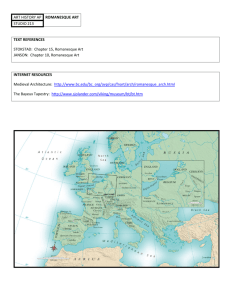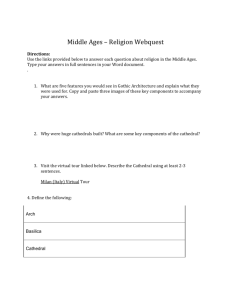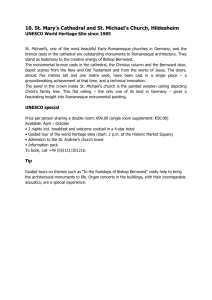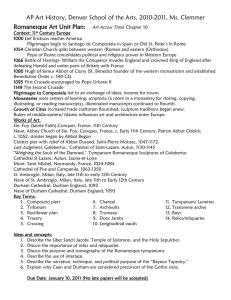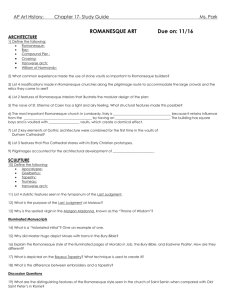Romanesque - Cloudfront.net
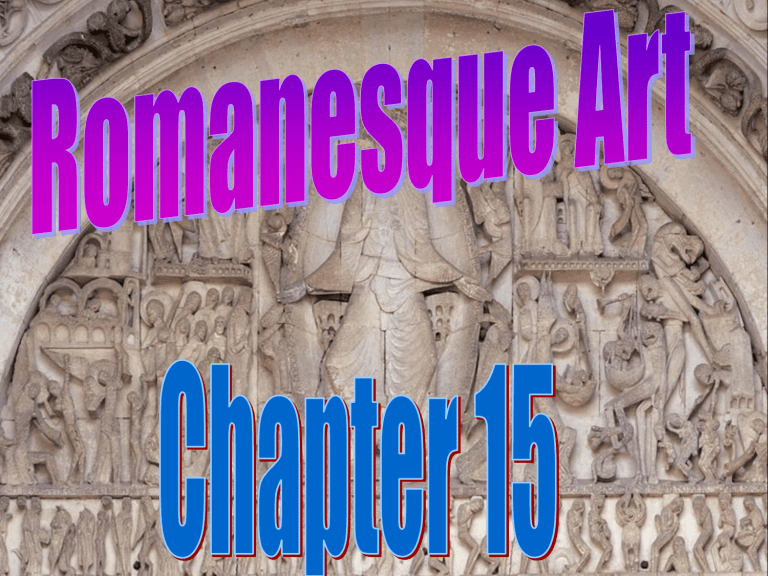
Objectives
• Understand the major regions of Europe in the Romanesque period and be sensitive to the stylistic differences among the regions, especially in the sphere of architecture.
• Become familiar with the major pilgrimage routes and destinations of the period.
• Familiarize yourself with key structural units of the vault, the rib, the buttress, and the organization of bays.
• Learn the parts of the portal of the typical Romanesque church and appreciate the role of sculpture in articulating the parts of the entrance.
• Recognize the enormous importance of relics and the legends of saints in the designation of holy places throughout Europe.
• Watch the re-emergence of monumental sculpture in Europe
(absent since the collapse of Rome).
• Learn the variety of artistic traditions drawn upon by Romanesque artists, including contemporary ones such as Islamic and Byzantine, and the continuing presence of ancient Roman art.
Good Stuff You Should Know
11 important aspects of Romanesque architecture
1.
“Romanesque” is the first international style since the Roman Empire. Also known as the “Norman” style in England
2.Competition among cities for the largest churches, which continues in the Gothic period via a “quest for height.”
3.Masonry (stone) the preferred medium.
Craft of concrete essentially lost in this period. Rejection of wooden structures or structural elements.
4. East end of church the focus for liturgical services. West end for the entrance to church.
ROMANESQUE ART
5.
Church portals as “billboards” for scripture or elements of faith.
6.Cruciform plans. Nave and transept at right angles to one another. Church as a metaphor for heaven.
7. Elevation of churches based on basilican forms, but with the nave higher than the side aisles.
ROMANESQUE ART
8. Interiors articulated by repetitive series of moldings. Heavy masonry forms seem lighter with applied decoration.
9. Bays divide the nave into compartments
10.Round-headed arches the norm.
11.Small windows in comparison to buildings to withstand weight
Historical Context
• Romanesque = in the Roman manner
• Feudalism dominated economic life
• Worcester Chronicle
– King/Nobles
– Churchmen
– Peasant Farmers
• Pilgrimages
– Holy places of Christianity
• Crusades
– A series of military expeditions against Islamic powers
Romanesque: Social overview
• Feudal system reaches peak
• Land is main source of wealth and power
• Church increases influence on daily lives
• Church is center of town
• Churches-
– testimony to power of Church
– faith of people
– skill of builders
ART
Compare Byzantine & Romanesque
Byzantine Romanesque
Mosaics, Icons
ARCHITECTURE Central-dome church
EXAMPLE Hagia Sophia
DATE 532-537 CE
PLACE Constantinople,
Turkey
Frescoes, stylized sculpture
Barrel-vault church
St. Sernin
Begun 1080 CE
Toulouse, France
Romanesque Overview
EMPHASIS
ELEVATION
MAIN TRAIT
SUPPORT SYSTEM
ENGINEERING
AMBIANCE
EXTERIOR
Horizontal
Modest Height
Rounded Arch
Piers, walls
Barrel vaults (and some
Groin)
Dark, solemn
Simple
Cathedral of Saint James
(Santiago Campostela)
• Held the body of Saint James
• Designed to accommodate crowds of pilgrims
• Served as administrative center
• Used 3 different kinds of vaults
– Ribbed
– Barrel
– Groin
St. James Cathedral
Santiago de Compostela
1078-1122
Spain
Cathedral Complex at Pisa
• Competed with Muslims over control of the western Mediterranean
• Built a cathedral dedicated to the Virgin
Mary
• Complex contains the cathedral, freestanding bell tower (campanile), and a baptistery.
Cathedral Complex
11 th Century
Pisa, Italy
Speyer Cathedral
• Soaring towers
• Wide transepts
• Triple aisled
• Red Sandstone
• Largest Romanesque Church
Speyer Cathedral
1080-1106
Germany
Durham Cathedral
• Served as a military outpost
• Stone and brick…NOT wood
– Reminded the Brits of ancient Rome
• Count-Bishop = Durham authority
• Architects divided each bay with two pairs of diagonal crisscrossing ribs
Durham Cathedral
1087-1133
England
Church of Saint-Etienne
• Founded by William the Conqueror in
1067
• Front divided in 3 vertical sections by 4 buttresses
• 6-Part vault
• Originally had a timber roof
• Towers were added during the Gothic period
St. Etienne
Normany, France
1060-77
VAULTING OF THE NAVE
• Sexpartite Vaults
Vaulted Ceilings
Ribs
Tribune / Gallery
Clustered Piers
Ambulatory
Dover Castle
12 th Century
England
St. Sernin
• Constructed to honor Saint Sernin
• Popularity increased when Charlemagne donated relics to the church
• An important stop for pilgrims on their way to Santiago de Compostela
• “Pilgrim Plan”
St. Sernin
1080-1120
Toulouse, France
Decoration of Buildings
• Revival of Monumental Stone Sculpture
• Reflects increasing importance of the
Virgin Mary
• Prophets, Bishops, ordinary people, monsters, animals, plants, geometric shapes.
• Heaven and Hell
archivolts
Romanesque Sculpture
tympanum lintel trumeau jambs
In the Romanesque period large scale sculpture revived.
It was always attached to architecture. Doors and capitals were figurated.
Creation and Fall
• Wiligelmus inspired by ancient sarcophagi
• Modena Cathedral
• Subjects from Genesis
– Creation and Fall
• Three Dimensionality
• Arcades give stage-like setting
• Was once painted
The Creation and Fall
West Façade of Modena Cathedral
Italy
1099
Jeremiah
South Portal Trumeau
Saint-Pierre
1115
Christ in Majesty, Tympanum of the South Portal at Saint-Pierre
1115-30
Last Judgment
• Cathedral of St. Lazare
• Christ returned to judge the souls at his feet
• Expressive Forms
• “May this terror frighten those who are bound by worldly error. It will be true just as the horror of these images indicates.”
Last
Judgment,
Tympanum by
Gislebertus
1130-35 CE
St.-Lazare
Autun,
France.
Last Judgment Gislebertus 1130-35 CE
Dancing Jesus
Detail of Last
Judgment
Weighing of the
Souls
1130-35 CE
Detail of Last Judgment, The Damned
Capital
Autun Cathedral
• Capitals continue dramatic story of sin, damnation, and salvation
Fallen Soul
Suicide of Judas
Capital of Saint-
Lazare
Autun, France
1125
Eve
by Gislebertus. Autun Cathedral.
Autun, Eve (Monica?)
Autun, Eve (Monica?)
Christ in Majesty
• Church of San Climent
• Catalunya, Spain
• Ruler and Judge of the World
• Alpha and Omega symbols
• Byzantine Flare
• Surrounded by 4 Evangelists
Crucifix
• Christ wearing royal robes
• Face = Deep sadness
• Robe designs meant to resemble Arabic script
– Islamic Spain
Bayeux Tapestry
• Depicts the Norman conquest of England
• 70 meters long
• One of the first recordings of a historical event shortly after it happened
ROMANESQUE ART
The Bayeux Tapestry
.
ROMANESQUE ART
Bayeux Tapestry 1066-1082 NORMAN or ROMANESQUE
ROMANESQUE ART
ISTI MIRANT STELLA = “These ones look at the star.”

